iHeartDogs is reader-supported. When you buy via links on our site, we may earn an affiliate commission at no extra cost to you.
When it comes to viral videos, they say that kids, cats and dogs rule the internet, and as parents, we’ll do anything to keep them safe. With all the buzz online about byproducts in processed pet foods and toxins contained in treats imported from overseas, it seems that a day rarely goes by that we don’t see headlines about another lawsuit or pet product recall.
But some dangers are already lurking inside our homes, in refrigerators, cupboards and on top of our kitchen tables. That’s right, many of the things we eat can be toxic foods to pets. Take salt and pepper for example: sodium presents the same health hazards for animals as it does for people and pepper is difficult for most pets to digest. And in considering pet safety, don’t forget about pesticides and pharmaceuticals, both over-the-counter and prescribed, which are also poisonous and potentially deadly for our animals. They should all be kept safely unavailable from curious cats and precocious pooches. Now, what foods are bad for dogs and cats? Let’s find out.

10 Most Toxic Foods To Pets
#1 – Chocolate

Chocolate is harmful to cats and dogs due to the presence of caffeine and theobromine, a compound that dogs metabolize much more slowly than humans. Theobromine is similar to caffeine and is found in all types of chocolate, but its concentration varies depending on the type. While it provides stimulating effects for humans, it’s highly toxic to dogs even in small amounts.
Theobromine affects the central nervous system and the cardiovascular system in dogs and cats. Since dogs process it much slower than humans, it can build up to toxic levels in their system. The level of toxicity depends on the type and amount of chocolate ingested, as well as your pet’s size.
Regarding theobromine content, here’s a listing of chocolate types from the most to the least:
- Cocoa Powder: It’s the most dangerous form, as it contains the highest concentration of theobromine.
- Unsweetened Baker’s Chocolate: Also very high in theobromine.
- Dark Chocolate: Has less theobromine than cocoa powder and baker’s chocolate but more than milk chocolate.
- Milk Chocolate: Contains lower amounts of theobromine but can still be toxic in higher doses.
- White Chocolate: Has the least theobromine, but its high fat content can cause other issues like pancreatitis.
If you suspect your pet has ingested chocolate of any type, look for these symptoms of chocolate toxicity in cats and dogs:
- Vomiting and diarrhea: These are often the first signs and can occur within a few hours of ingestion.
- Restlessness and hyperactivity: Due to the stimulating effects of theobromine, pets may pace or won’t be able to sit still.
- Increased heart rate: This increase leads to abnormal rhythms.
- High blood pressure
- Seizures: In severe cases, pets may experience convulsions.
- Muscle tremors or twitching
- Collapse and death: May occur in extreme cases of toxicity.
It’s crucial that pet parents keep chocolate out of reach of their cats and dogs and seek veterinary attention immediately if ingestion occurs.
#2 – Caffeine

Caffeine is highly toxic to pets because their bodies cannot metabolize or process it as efficiently as humans can. This compound, found in coffee, tea, soda, energy drinks, and certain medications, stimulates the nervous system. In pets, even small amounts can cause serious health issues.
The primary reason caffeine is dangerous for pets is its effect on the central nervous system and cardiovascular system. It can lead to an increased heart rate, hyperactivity, and even seizures. Pets are more sensitive to the effects of caffeine than humans, so even a small amount can be harmful.
Symptoms of caffeine toxicity in pets include:
- Hyperactivity: Pets may appear unusually active or restless.
- Restlessness: Difficulty settling or staying still.
- Vomiting: This may occur as the body tries to rid itself of the toxin.
- Elevated heart rate: The heart may beat faster than normal.
- High blood pressure: This can lead to further complications.
- Tremors: Involuntary shaking or twitching muscles.
- Seizures: In severe cases, pets may experience convulsions.
- Collapse: In extreme cases, caffeine toxicity can lead to collapse or death.
Contact your vet right away if your pet has gotten into a caffeine source. There is no antidote for caffeine poisoning, so treatment is supportive and symptomatic. This may include inducing vomiting, administering activated charcoal to absorb the caffeine, and providing fluids and medications to support heart and nervous system function.
Prevention is the best approach. Keep all sources of caffeine out of your pet’s reach and be mindful of potential sources like spilled coffee or tea, coffee grounds, and over-the-counter medications that may contain caffeine.
#3 – Milk
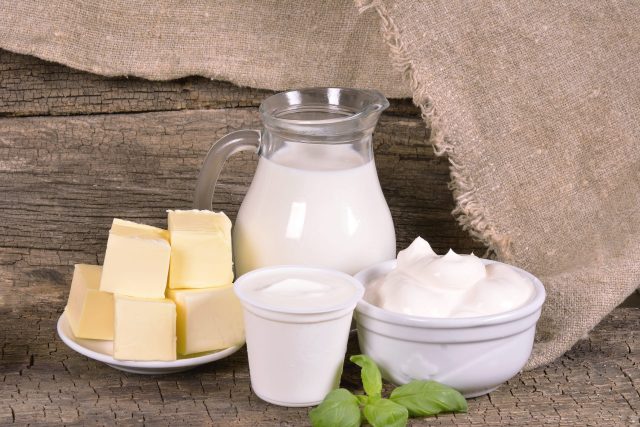
The image of a cat sipping milk from a saucer is one many people conjure, but milk is not good for cats. But did you know milk is bad for dogs too? Milk and other dairy products can be harmful to pets due to their inability to properly digest lactose, a sugar found in milk. While kittens and puppies produce ample lactase, the enzyme needed to break down lactose, their ability to do so typically decreases as they grow older. This decrease in lactase production means that many adult pets are lactose intolerant.
When a lactose-intolerant pet consumes milk, the undigested lactose passes through their gastrointestinal system and draws water into the gut, leading to diarrhea. Additionally, undigested lactose in the colon ferments, producing gas and causing discomfort.
Symptoms of lactose intolerance in pets include:
- Diarrhea: Loose or watery stool is common after consuming milk.
- Gas: Increased flatulence can occur.
- Bloating: The stomach may appear swollen or feel hard.
- Abdominal discomfort: Pets may show signs of pain or discomfort in their abdomen.
- Nausea: Some dogs or cats may appear nauseated or refuse food.
- Vomiting: In some cases, pets may vomit after consuming milk.
If your cat or dogs accidentally consumes milk and shows these symptoms, it’s generally not life-threatening, and the discomfort should pass as the milk moves through their system. However, it’s advisable to offer small amounts of water to keep them hydrated and avoid dairy products in the future.
To prevent gastrointestinal distress, avoid giving milk and dairy products to dogs and cats. If you wish to offer a milk-like treat, there are lactose-free pet milk products available that are safer options. Always consult with your veterinarian before introducing new foods into your pet’s diet.
#4 – Macadamia Nuts
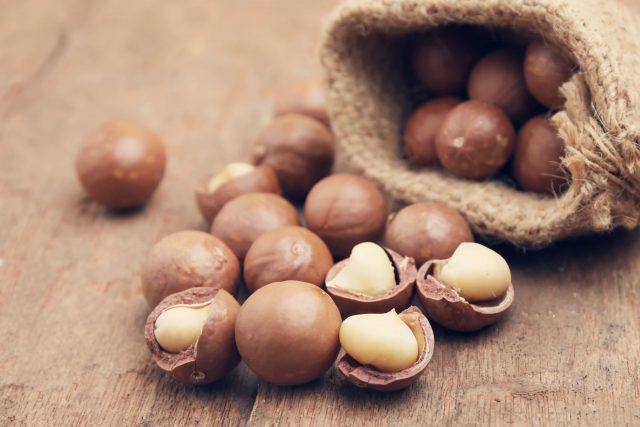
Macadamia nuts are particularly toxic to dogs, and to a lesser extent, to other pets. The exact compound that causes toxicity is not fully known, but the effects are well-documented. Dogs that consume macadamia nuts can experience a range of symptoms, some of which may be severe.
The toxic mechanism of macadamia nuts in dogs is not entirely understood. Unlike some other foods that are toxic to pets, macadamia nuts do not contain a known toxin like theobromine in chocolate. Instead, it’s believed that a compound or a combination of compounds in these nuts triggers a toxic reaction in dogs.
Symptoms of macadamia nut toxicity in pets, particularly dogs, include:
- Weakness, especially in the hind legs: Affected dogs may appear unable to stand or walk properly.
- Vomiting: This is a common reaction as the body tries to expel the toxin.
- Tremors: Dogs may exhibit muscle tremors or shaking.
- Hyperthermia: An elevated body temperature can occur.
- Lethargy: Dogs may appear unusually tired or unresponsive.
- Abdominal pain: Discomfort or pain in the stomach area may be evident.
The severity of symptoms can vary based on the amount of nuts ingested and the size of the dog. Most dogs recover with supportive care, but severe cases may require veterinary intervention. Treatment typically involves supportive care, including intravenous fluids to maintain hydration and medications to control symptoms like tremors and pain. There is no specific antidote for macadamia nut poisoning.
Prevention is straightforward: avoid giving macadamia nuts to dogs. This includes foods that may contain these nuts, such as baked goods or snacks. Always check the ingredients of any human food before offering it to your pet. If you suspect your dog has eaten macadamia nuts, contact your veterinarian immediately.
#5 – Onions and Garlic

Onions and garlic, along with other members of the Allium family (such as leeks, chives, and shallots), are toxic foods to pets, especially dogs and cats. These foods contain compounds called thiosulfates, which pets cannot digest effectively. When consumed in significant amounts, thiosulfates can cause oxidative damage to red blood cells, leading to hemolytic anemia, a condition where red blood cells are destroyed faster than they can be made.
Symptoms of onion and garlic toxicity in pets include:
- Vomiting and diarrhea: These are often the first signs of gastrointestinal irritation.
- Lethargy: Pets may appear unusually tired or weak.
- Abdominal pain: You may notice signs of discomfort in your pet’s stomach area.
- Pale or yellow gums: This is a sign of anemia.
- Elevated heart rate: This can occur as the body tries to compensate for the reduced oxygen-carrying capacity of the blood.
- Difficulty breathing: In severe cases, due to the reduced oxygen-carrying capacity of the blood.
- Collapse: In very severe cases of anemia.
The toxicity of onions and garlic is dose-dependent, and symptoms can vary depending on the amount consumed and the size of the pet. Even small, regular doses, such as those found in seasoned food, can be harmful over time.
If you suspect your pet has ingested onions or garlic, immediate veterinary attention is crucial. Treatment may involve inducing vomiting, administering activated charcoal solutions, like Dr. Cuddles Ready Rescue, to limit absorption, and providing supportive care, including blood transfusions in severe cases.
Preventive measures include keeping onions, garlic, and related foods out of reach and avoiding feeding pets table scraps or foods seasoned with these ingredients.
#6 – Avocado
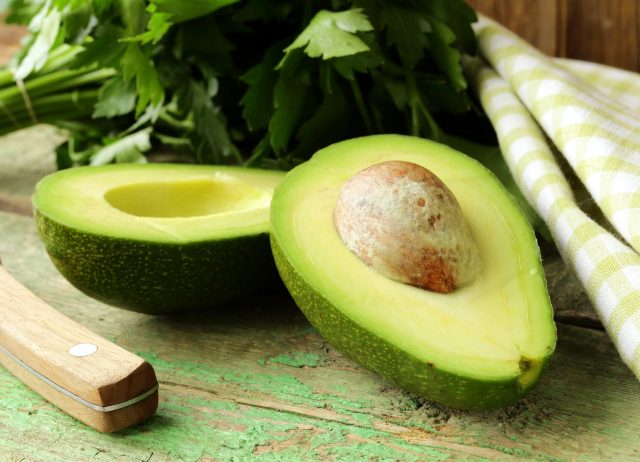
Avocado contains a substance called persin, a fungicidal toxin that is toxic to some pets, especially birds, rabbits, horses, and goats. In dogs and cats, the reaction to avocado varies, with some showing mild or no symptoms, while others may be more sensitive. Ingestion of avocado flesh or peel can lead to vomiting and diarrhea in sensitive pets. Another risk is the avocado pit, due to the risk of choking or intestinal blockage.
Symptoms of avocado consumption in pets, particularly dogs and cats, include:
- Vomiting: This is a common reaction as the body tries to expel the irritant.
- Diarrhea: Pets may experience loose or watery stools.
- Abdominal discomfort: Signs of pain or discomfort in the stomach area may be observed.
- Difficulty breathing: In rare cases, if the pit is ingested, it can lead to obstruction of the airway.
- Choking or blockage: The pit can get stuck in the esophagus, stomach, or intestinal tract, leading to serious complications.
The severity of symptoms can vary based on the amount of avocado ingested and the size and species of the pet. Dogs and cats who consume a small amount of avocado flesh may not show any adverse effects, while birds and other pets are at a higher risk of persin toxicity.
If your pet ingests avocado, particularly the pit, it is advisable to seek veterinary attention. Treatment will depend on the symptoms and may include inducing vomiting, providing supportive care for gastrointestinal upset, or surgery in case of an obstruction caused by the pit.
Prevention involves keeping avocados, especially the pits, out of reach of pets. When disposing of avocado pits, do so in a manner that prevents pets from accessing them.
#7 – Grapes and Raisins
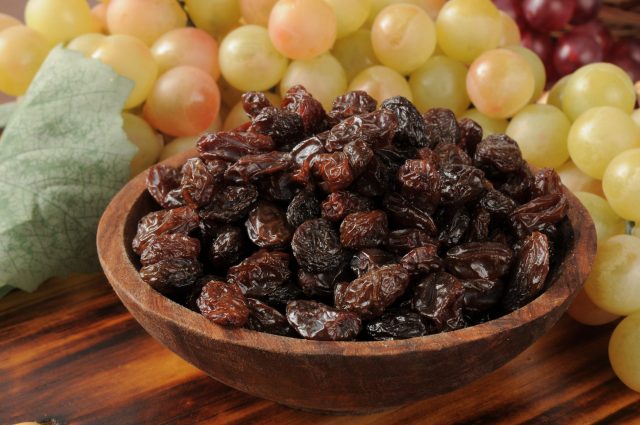
Grapes and raisins are highly toxic foods to pets, especially dogs, and the exact cause of their toxicity is not yet fully understood. Even small amounts can lead to rapid kidney failure and other serious health issues. This toxicity is idiosyncratic, meaning some dogs can ingest grapes or raisins without apparent effects, while others may have severe reactions from a minimal amount. But it’s not worth trying, so don’t feed your pets grapes or raisins.
Symptoms of grape or raisin toxicity in pets include:
- Vomiting and Diarrhea: These are often the first symptoms and can occur within a few hours of ingestion. Vomiting may be repeated and severe.
- Loss of Appetite: Affected pets may show a decreased interest in food.
- Lethargy: Pets may become unusually weak and unresponsive.
- Abdominal Pain: You may notice signs of discomfort or pain in your pet’s stomach area.
- Dehydration: Indicated by dry nose, mouth, and gums, and decreased urine output.
- Increased Thirst and Urination: Initially, followed by a decrease in urine production as kidney damage progresses.
- Kidney Failure: In severe cases, signs of kidney failure (such as decreased or absent urine production) can develop within a day or two.
The exact compound causing toxicity is unknown, and there’s no known safe amount of grapes or raisins for pets. Any ingestion should be considered a potential emergency.
If your pet eats grapes or raisins, immediate action is vital:
- Do not wait for symptoms to appear before seeking veterinary care.
- Contact your vet or a pet poison helpline for advice.
- Prompt veterinary treatment is crucial. Treatment typically includes inducing vomiting if ingestion was recent, administering activated charcoal to prevent further absorption, and intravenous fluids to support kidney function and prevent dehydration.
Prevention involves keeping grapes, raisins, and any foods containing them out of your pet’s reach. Educate all household members about the dangers these foods pose to pets.
#8 – Raw Eggs

Feeding raw eggs to pets, particularly dogs and cats, poses several health risks. While some pet parents believe raw eggs can be a healthy protein source, the risks often outweigh the benefits. Raw eggs can be contaminated with bacteria like Salmonella and E. coli. These bacteria can cause serious gastrointestinal problems in pets. Also, raw egg whites contain avidin, an enzyme that interferes with the absorption of biotin, a B vitamin essential for healthy skin and coat. Prolonged feeding of raw egg whites can lead to biotin deficiency.
Symptoms of issues related to consuming raw eggs in pets include:
- Vomiting and Diarrhea: Symptoms of a bacterial infection, often accompanied by fever and lethargy.
- Poor Coat Condition: Due to biotin deficiency, pets may have a dull, unhealthy coat.
- Skin Issues: Pets may suffer from skin infections or irritations, again due to biotin deficiency.
- Lethargy: General weakness or lack of energy can be a sign of a systemic infection.
If your pet consumes raw eggs and shows these symptoms, it’s important to consult a veterinarian. Treatment for bacterial infection usually involves antibiotics and supportive care, such as fluids and rest. For biotin deficiency, a change in diet and possible biotin supplementation may be recommended.
To prevent these risks, avoid feeding raw eggs to your dog or cat. Cooked eggs can be a healthy addition to a pet’s diet, but only in moderation and after consulting with a veterinarian. This ensures that the diet remains balanced and safe for your pet’s specific health needs.
#9 – Alcohol

Alcohol is extremely dangerous for pets and can lead to serious health complications, even in small amounts. Pets are much more sensitive to alcohol than humans due to their smaller size and differences in metabolism. Alcohol can be found in beverages, certain foods, and some household products.
The risks of alcohol consumption in dogs and cats include:
- Depressed Central Nervous System: Alcohol depresses the brain functions in pets, leading to a lack of coordination, confusion, and stupor.
- Low Blood Sugar and Blood Pressure: Alcohol can cause a significant drop in blood sugar and blood pressure, leading to weakness and collapse.
- Hypothermia: Pets may experience a dangerous drop in body temperature.
- Acidosis: Alcohol can lead to a dangerous increase in the acidity of the blood.
- Seizures and Respiratory Failure: In severe cases, alcohol poisoning can cause seizures, coma, and even respiratory failure, which can be fatal.
Symptoms of alcohol consumption in pets include:
- Vomiting and Diarrhea: The body’s reaction to ingesting a toxic substance.
- Disorientation and Staggering: Impaired coordination and balance.
- Excessive Drooling or Nausea: Indicative of gastrointestinal upset.
- Lethargy or Weakness: Due to lowered blood sugar and blood pressure.
- Respiratory Distress: Difficulty breathing, which can be severe.
- Tremors or Seizures: In severe cases, indicative of neurological effects.
- Collapse or Coma: In extreme cases of toxicity.
Immediate veterinary care is crucial if a pet ingests alcohol. Treatment may include inducing vomiting if ingestion was recent, administering activated charcoal to limit absorption, intravenous fluids to support organ function, and medications to control symptoms like seizures.
Prevention involves keeping alcoholic beverages, foods containing alcohol, and household products containing alcohol out of reach of pets. Always be cautious during social gatherings or in environments where alcohol is present to ensure your pet’s safety.
#10 – Bones and Fat

Bones and fat, often considered traditional treats for pets, can actually pose significant health risks, particularly for dogs and cats. While they might seem like natural choices, they can lead to serious complications, landing them a spot on our list of toxic foods to pets.
Why Bones Are Bad:
- Choking Hazard: Small bones or bone fragments can get lodged in the throat or gastrointestinal tract.
- Intestinal Obstructions: Bones can become stuck in the intestines, requiring surgical removal.
- Internal Injuries: Sharp bone fragments can puncture the digestive tract.
- Dental Problems: Bones can break teeth or damage the gums.
- Constipation: Bone fragments can lead to constipation or impaction, especially if they are not fully digested.
Why Fat Is Bad:
- Pancreatitis: High-fat foods can trigger pancreatitis, a painful inflammation of the pancreas. Symptoms include vomiting, diarrhea, abdominal pain, and lethargy.
- Obesity: Excess fat contributes to weight gain, leading to obesity and related health problems like diabetes and joint issues.
- Gastrointestinal Upset: Consuming a large amount of fat can cause diarrhea and vomiting.
If your cat or dog eats bones or fat and shows any of the following symptoms, call your vet right away:
- Vomiting and Diarrhea: Indicating gastrointestinal distress.
- Abdominal Pain: Pets may appear uncomfortable or in pain.
- Lethargy: Decreased energy levels or unresponsiveness.
- Difficulty Defecating: Due to constipation or impaction from bones.
- Coughing or Gagging: If a bone is stuck in the throat.
- Sudden Weight Loss: In severe cases of obstruction or pancreatitis.
If your pet consumes bones or excessive fat and shows these symptoms, seek veterinary care immediately. Treatment may involve x-rays to locate bone fragments, surgery for obstructions, intravenous fluids for dehydration, and medications to relieve symptoms.
Prevention is key: avoid giving your pets bones or fatty foods. Opt for safer, vet-recommended treats and maintain a balanced diet to ensure their health and wellbeing.
What To Do If Your Pet Eats Toxic Food
If you suspect your furry friend has eaten something harmful, act fast. Here’s what to do if your dog or cat eats chocolate, raisins, or any other toxic food to pets:
- Identify the Toxic Substance: Determine what the dog has eaten and how much. This information is critical for the vet.
- Call Your Veterinarian or Pet Poison Helpline: Immediate professional advice is essential. Provide them with details about what your dog ate, the amount, and any symptoms. Have the contact information for your vet’s office and the Pet Poison Hotline.
- Do Not Induce Vomiting Unless Instructed: Inducing vomiting at home can be dangerous. It should only be done if a veterinarian specifically advises it.
- Follow Professional Advice: This may include bringing your dog to the clinic immediately or administering first aid at home as directed. Having an at-home detoxifier, like Dr. Cuddles ReadyRescue, is an important part of your emergency response. For cats and dogs, it’s easy to administer and has five-year shelf life.
- Monitor Your Dog Closely: Watch for any symptoms of poisoning, which can vary based on the toxic substance ingested.
- Prevent Future Incidents: Once the immediate danger is over, take steps to prevent future incidents. Store toxic foods out of reach and educate everyone in the home about pet-safe practices.
Having Dr. Cuddles ReadyRescue on hand can be invaluable when your pet eats a toxic food. The activated carbon spheres go to work fast to absorb toxins, buying time when every moment matters. It’s a lifesaving emergency essential for dogs and cats. Store one in your pet’s first aid kit.
Understand the Dangers of Toxic Foods To Pets
Understanding the dangers of certain foods to pets is crucial for their health and well-being. Foods like chocolate, caffeine, milk, macadamia nuts, onions, garlic, avocado, grapes, raisins, raw eggs, alcohol, bones, and fatty foods can cause a range of serious health issues in pets. Symptoms of toxicity can vary from gastrointestinal distress to more severe conditions like kidney failure or pancreatitis. As pet parents, it’s our responsibility to ensure the safety of our furry friends by keeping these harmful items out of their reach. Always consult with a veterinarian before introducing new foods into your pet’s diet and opt for pet-safe treats. Remember, what’s harmless to humans can be life-threatening to pets, and prevention is key to keeping our beloved companions safe and healthy.
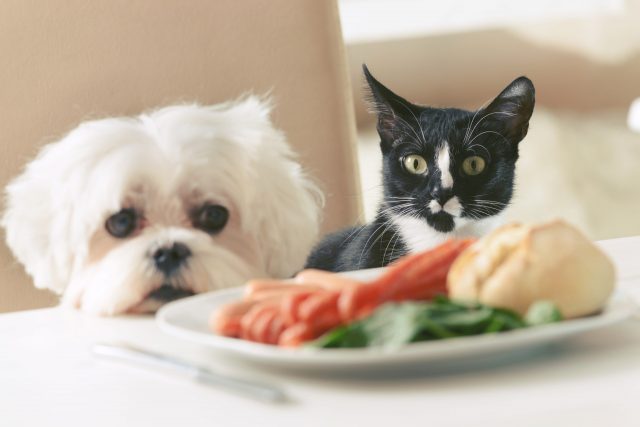

 Toledo, United States.
Toledo, United States.